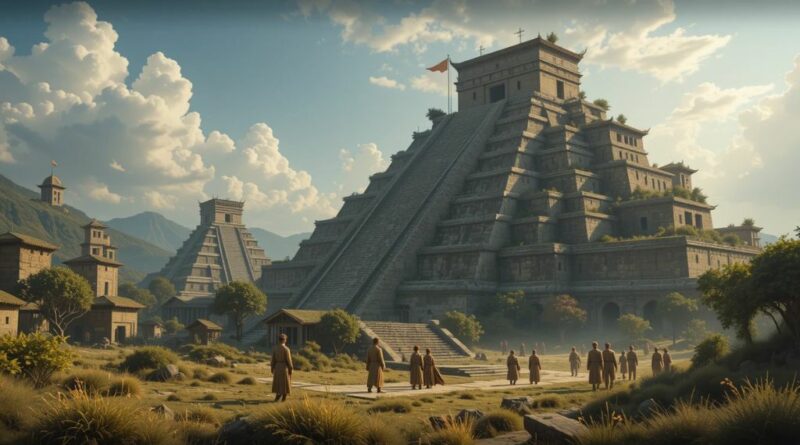The Vanished People: Colombia’s 6,000-Year-Old Genetic Mystery
Archaeological Discovery Reveals an Ancient Population That Disappeared Without Trace
High in the misty plateaus of Colombia’s Bogotá Altiplano, researchers have uncovered one of archaeology’s most perplexing mysteries. DNA analysis of 21 sets of human remains spanning 6,000 years has revealed a population that existed in complete genetic isolation — a group of people who appear to have no ancestors or descendants in the archaeological record.
The discovery, published in the prestigious journal Science Advances, challenges our understanding of how the Americas were populated and raises fundamental questions about the complex patterns of ancient migration across South America.
The Highland Mystery
The ancient remains from the Checua archaeological site, located about 3,000 metres above sea level near Bogotá, date back approximately 6,000 years. These individuals belonged to what researchers believe was the earliest wave of human migration into this region of South America. Yet their genetic signature tells a story unlike any other found in the Americas.
Unlike typical archaeological discoveries that connect ancient peoples to modern populations, this group dating back 6,000 years stood out for having a genetic profile not seen before in any ancient or modern American population. The implications are staggering: these people lived, thrived, and then vanished from the genetic record as completely as if they had never existed.
A Complete Replacement
What makes this discovery particularly remarkable is the evidence for what researchers describe as a “major genetic replacement event.” The analyses provide strong evidence for a major genetic replacement in the Altiplano between 6,000 and 2,000 years ago. This wasn’t a gradual mixing of populations — it was a complete transformation.
The hunter-gatherers who first settled the Bogotá Altiplano established a way of life that would persist for millennia. Over the course of 4,000 years, they gradually transitioned from their nomadic hunting and gathering lifestyle to become settled agriculturalists. They developed sophisticated techniques for cultivating crops at high altitude and created complex social structures that allowed them to thrive in the challenging mountain environment.
Then, sometime around 2,000 years ago, they disappeared entirely from the genetic record. From 2,000 years ago onward, human remains in the area show a completely different genetic profile. The replacement was so thorough that no trace of the original population’s DNA can be found in subsequent archaeological layers.
The Chibchan Connection
One of the few clues to understanding these vanished people lies in their potential connection to Chibchan language speakers. Chibchan languages were spoken before 1500 CE in the area now comprising Nicaragua, Costa Rica, Panama, western Colombia, and Ecuador, with the extinct Muisca language being part of this family.
The genetic analysis suggests these ancient Colombians had stronger connections to populations from the Isthmus of Panama — the narrow strip of land that connects North and South America — than to other Indigenous groups within Colombia itself. More ancient Panamanians were found to be related to modern Chibchan speakers than ancient Colombians.
This connection hints at a fascinating possibility: these mysterious people may have been part of a broader network of Chibchan-speaking populations that once stretched across Central America and northern South America. Studies indicate Chibchan-speaking populations originated in Mesoamerica, spreading to northern South America in prehistoric times.
The Greater Context of American Peopling
To understand the significance of this discovery, it’s essential to consider the broader story of how the Americas were populated. Current scientific consensus suggests that the ancestors of Indigenous Americans originated from Siberian and East Asian populations who mixed around 20,000 years ago during the Late Paleolithic period. These ancestral groups then crossed the Bering land bridge to North America approximately 16,000 years ago.
Once in the Americas, this ancestral lineage split into northern and southern Native American branches. The southern branch eventually gave rise to three distinct lineages that spread throughout South America, each following different migration routes and adapting to diverse environments from the Amazon rainforest to the high Andes.
The Colombian discovery suggests that this migration pattern was far more complex than previously understood. Rather than simple, linear movements of people from north to south, the evidence points to a dynamic process of population movements, replacements, and genetic mixing that varied dramatically across different regions.
Archaeological Methods and Breakthrough Technology
The breakthrough in understanding these ancient Colombians came through advances in ancient DNA analysis. Researchers extracted genetic material from bone fragments that had survived thousands of years in the Colombian highlands’ unique preservation conditions.
The high-altitude environment of the Bogotá Altiplano, with its cool temperatures and specific soil chemistry, provided ideal conditions for DNA preservation. This allowed scientists to reconstruct detailed genetic profiles from individuals who lived millennia ago, revealing population structures and migration patterns that would otherwise remain hidden.
The research team analysed both mitochondrial DNA (inherited through the maternal line) and nuclear DNA to create comprehensive genetic profiles. This dual approach provided insights into both maternal lineages and broader population genetics, painting a detailed picture of these ancient communities.
Implications for Understanding Pre-Columbian History
This discovery has profound implications for our understanding of pre-Columbian history in South America. It suggests that the archaeological landscape of Colombia was far more complex than previously imagined, with multiple waves of migration, settlement, and population replacement occurring over thousands of years.
The complete disappearance of the original Altiplano population raises important questions about the dynamics of ancient societies. What caused this genetic replacement? Was it due to disease, warfare, environmental changes, or voluntary migration and intermarriage? The archaeological record provides tantalising clues but no definitive answers.
The Search for Missing Links
One of the most intriguing aspects of this discovery is what it reveals about the gaps in our archaeological knowledge. If a entire population could exist for 4,000 years and then vanish from the genetic record, what other “lost” populations might be waiting to be discovered?
The research team acknowledges that much more genomic research will be needed to fully understand who these unknown people were and how they fit into the broader tapestry of American prehistory. Future excavations and DNA analyses from sites across Colombia and neighbouring countries may reveal additional pieces of this genetic puzzle.
Modern Connections and Cultural Continuity
Interestingly, the study also examined more recent remains from the region, including those of the Muisca people who inhabited the area during the final millennium before European contact. DNA from Muisca individuals, who lived in the region during the last 1,000 years, confirms their connection to these earlier groups.
The Muisca were known for their sophisticated goldworking, complex social organisation, and the famous legend of El Dorado. Their genetic connection to later populations in the region suggests that while the original hunter-gatherers disappeared, the area continued to be an important centre of human settlement and cultural development.
Future Research Directions
This discovery opens numerous avenues for future research. Scientists are particularly interested in expanding their genetic sampling to include more sites across Colombia and the broader region. By comparing genetic profiles from different time periods and locations, researchers hope to reconstruct the complex migration patterns that shaped pre-Columbian South America.
Environmental archaeology will also play a crucial role in understanding these ancient populations. By studying ancient climate records, plant remains, and other environmental indicators, researchers can better understand the ecological context in which these people lived and potentially identify factors that contributed to their disappearance.
A Window into Deep Time
The vanished people of the Bogotá Altiplano remind us that human history is far more complex and dynamic than we often imagine. Their story — of migration, adaptation, cultural development, and ultimate disappearance — reflects the broader human experience of movement and change across millennia.
As DNA technology continues to advance and more archaeological sites are excavated, we can expect further revelations about the hidden populations of the Americas. Each discovery adds another piece to the puzzle of human migration and settlement, revealing the rich tapestry of cultures that flourished in the Americas long before European contact.
The mystery of Colombia’s vanished people may never be fully solved, but their genetic legacy continues to inform our understanding of humanity’s remarkable journey across the Americas. In their disappearance, they have left us with one of archaeology’s most compelling mysteries — and a profound reminder of how much we still have to learn about our shared human past.
We’d love your questions or comments on today’s topic!
For more articles like this one, click here.
Thought for the day: “If you love somebody, let them go, for if they return, they were always yours. And if they don’t, they never were.” Khalil Gibran



